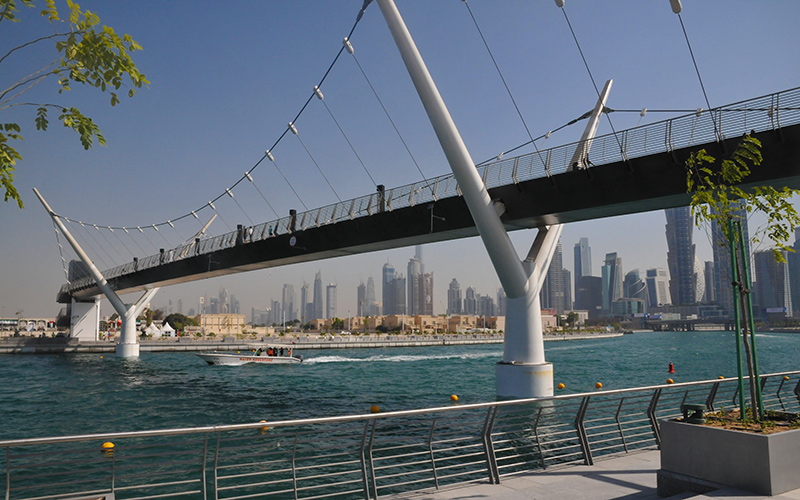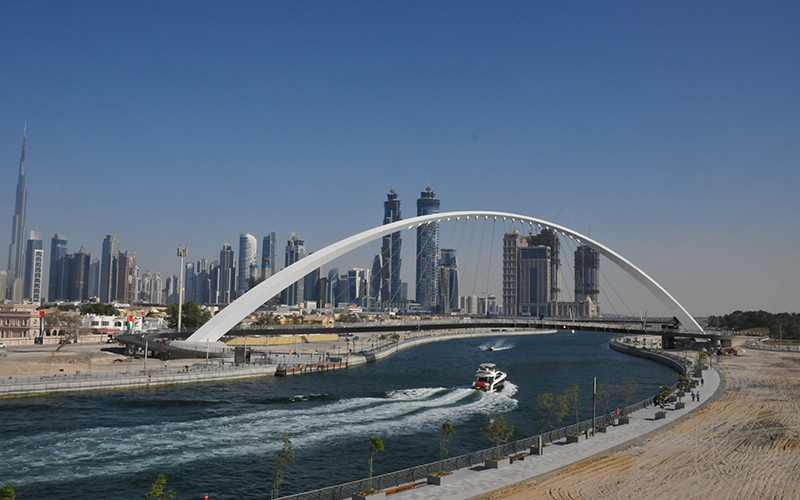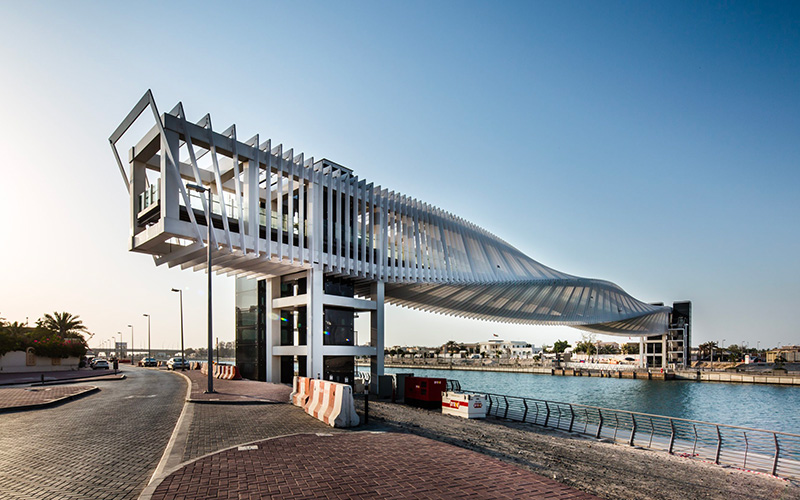
In 1894, Dubai was declared a free port by Sheikh Maktoum bin Hasher, and its commercial development enjoyed a significant boost. Taking advantage of the increase of Iran’s port taxes, the Sheikh started a strategic financial plan transforming the city in a tax haven.
In the mid-twentieth century, the city center was rebuilt, and a new urban policy began. Sheikh Rashid bin Saeed Al Maktoum’s investments in infrastructure projects turned Dubai into an international commercial and touristic hub (Dubai Creek expansion, Rashid and Jabel Ali ports, and Dubai World Trade Center), thanks also to the discovery of oil fields (1966) and the following birth of the United Arab Emirates (1971).
It is although in the first decade of the new millennium that the building sector grew exponentially, transforming Dubai into a futuristic metropolis. Under the government of Sheikh Mohammed bin Rashid Al Maktoum, new ambitious projects took place, such as the Burj Al Arab, Burj Khalifa and Palm Islands: The Sheikh implemented a forward-looking expansion strategy in tourism and attraction of foreign investments.
Today, between residents and temporary workers, Dubai hosts 3 million inhabitants and, thanks to economic diversification, less than 40% of the GDP originates from oil. Dubai has become an intercultural city that mixes the traditions of the ancient Arab culture with futuristic constructions and advanced technologies.
In October 2013, Dubai announced a futuristic urban project that would change its shape: the Dubai Water Canal.
The Dubai Water Canal was one of the biggest projects ever implemented in Dubai. A project with low environmental impact, it involved three different areas: the first included the construction of a 3.2 km-long canal linking Dubai’s financial center to the Arabian Gulf, along with pedestrian and road bridges; the second included a green area between Safa Park and the new Jumeirah Beach Park and the third included the construction of public spaces with restaurants, entertainments areas and bike paths.
The excavation of the canal began in 2014: 3 million m³ of sand were extracted, 150,000 tons of cement and 25,000 tons of steel were used. The project involved 4,650 people from all over the world and took 20 million hours to complete.
Beside the aesthetic impact, the project also had significant environmental benefits. By increasing the flow of water, its quality would improve by 33 percent and, at the same time, help to lower ambient temperature.
| Canal length | 3.2 km |
| Canal width | 80-120 m |
| Sand extraction | 3 million m³ |
| Water held | 7.8 million m³ |
| Number of workers | 4.650 |
| Amount of work | 20 million hours |
| Cement used | 150.000 tons |
| Steel used | 25.000 tons |
Maeg entered the Dubai Water Canal project and the Road and Transport Authority (RTA) assigned it the task to build three pedestrian bridges crossing the canal.

In May 2016, Maeg won the tender as a subcontractor of the main contractor, Besix. According to the project, Footbridge1 (FB1) is 120 meters long and it is supported by a cable system linked to two steel antennas; Footbridge2 (FB2) is 205 meters long and it has an S-shaped suspended deck, supported by an arch rising 50 meters from the ground level; Footbridge3 (FB3) initially was a tubular structure redesigned by order of the RTA to become a helical parallelepiped winding over itself.
The construction works for FB1 and FB2 began in the workshops in the Summer of 2016, then they were shipped to site to be finalized and installed. To create the complex structure of FB3, Maeg’s technical office created a tailor-made solution to apply the right torsion to each block and, at the end of September, FB3 was shipped to the construction site.




Dubai is in the desert. In Summertime the average temperature can sometimes rise above 40 degrees Celsius. High temperature and Persian Gulf humidity make the air muggy.
From June 15th to September 15th, to protect the health of workers in the construction site a mandatory break to works between 12:30 pm and 3:00 pm was introduced by the UAE.
FB1
Featuring a slender and light structure, FB1 was installed when the canal had not yet been flooded with water. To facilitate transportation from the factory, the deck was shipped split into 11 segments to be installed on temporary towers. The cable-stretching process between the antennas and the deck makes the bridge a self-supporting structure.
FB2
The 9 segments that make up the 205-meter long arch were assembled on the ground, raised in position by 600 tons cranes and then welded. Given the upcoming planned flooding of the canal, the installation of the 20 cables took place firstly on the ground and then directly from the two banks, taking advantage of the cranes boom.
FB3
Since the scheduled flooding of the canal was imminent, a temporary steel underbridge was installed on temporary towers. Doing so allowed welding at a height the pre-assembled segments. Subsequently, the underbridge was hooked to a barge that exploiting the low tide slid it out of its position, allowing its removal.






On November 9th, the Dubai Water Canal was officially inaugurated and opened to the public.
The grand opening took place in true Dubai-style with dance performances, fireworks and a laser beam show in the sky at the presence of the Sheikh Mohammed bin Rashid Al Maktoum.
The Dubai Water Canal gave the city a new look, making it a full-fledged island in the desert.
With their unique design, the Maeg footbridges are now a new Dubai’s skyline attraction.
Mohammed bin Rashid Al Maktoum
UAE Vice President,
Prime Minister and Ruler of Dubai
CREDITS
Initial video: S3 Channel, Greg Florent, View from Above, Carsten Bachmeyer
Dubai Water Canal video: First and Ten Productions, Real Image TV Production
Construction site video: Real Image TV Production
Epilogue video: Real Image TV Production, Prodea Group SpA
PARTNER







